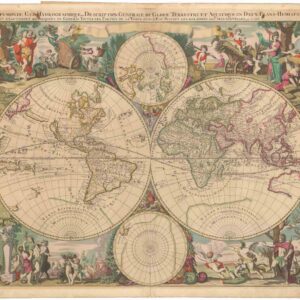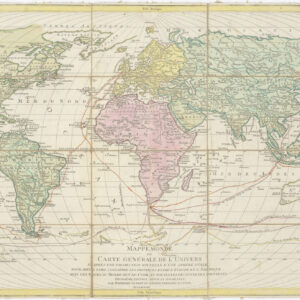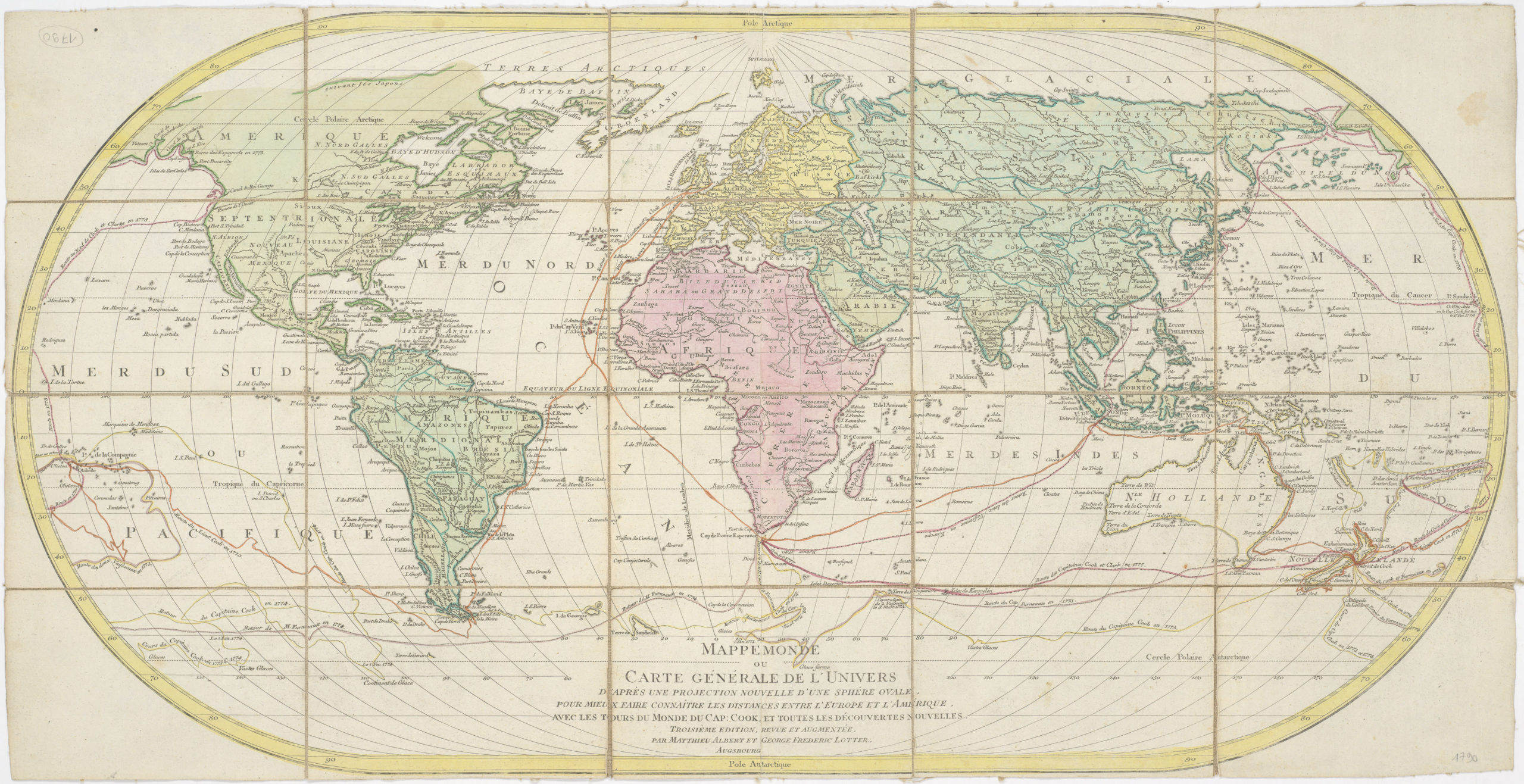A personal document of Victorian-era travel — a vivid reminder of British power in the 19th century, and the many personal histories that formed the Empire.
[Victorian Travel] 19th century linen-backed manuscript sea chart
Out of stock
Description
This large hand-drawn manuscript map charts the course of three English ships sailing through international waters in the 1860s. Even though focus is on the respective maritime route, the chart maps out a number of relevant landmasses in great detail, including all of Africa, Europe (minus Scandinavia), most of the Asian landmass, western Brazil, and Newfoundland. Unlike the Indian Ocean, which only has Madagascar shown, most of the relevant clusters of Atlantic islands have been meticulously drawn in and labelled. These include the Azores (Western Islands), the Canaries, the Cape Verde Islands, Ascension, St Helena, and Tristan da Cunha.
The chart documents the voyages of three distinct ships in great detail. Each ship is named; its route plotted in and provided with information like dates, winds, stopping points, etc. In the upper right and lower left corner of the map, annotations provide some background on two of the ships, the Conflict and the Siam.
The Conflict sailed from the Gravesend Docks west of London on July 9th 1864. She was bound for Calcutta, which since 1772 had been the imperial capital of British India and the seat of the British Viceroy. On board was a contingent of soldiers that included the map’s author. The soldiers were being sent on imperial posting for the British Army in India. The annotation in the lower left of the map informs us that they arrived safely at Calcutta on October 15th, after spending 99 days at sea.
The route of the Conflict has been carefully drawn on to the map, with daily positions, underlining that its maker, Lieutenant Wace, was on board himself (the provenance of the map traces to Wace’s personal estate). We find the first positioning of the Conflict just off the coast of Bretagne on July 12th 1864 – three days out of dock – and can then follow her route (a thin dotted line in purple) as she tacks south-southwest, drawing closer to Brazil than the African coast and sailing so far south that there is a brief stopover at the isolated South Atlantic island of Tristan da Cunha on July 25th. After this stop, the Conflict chases a southern route round the Cape of Good Hope, through the southern Indian Ocean, before veering sharply north and sailing into the Bay of Bengal in early October.
The second plotted route belongs to the Siam, which the annotations in the upper left corner tell us sailed from London on June 1st 1866 bound for Auckland, New Zealand. Fortunately, the note also informs us that she arrived safely there after 99 days at sea and traversing no less than 16,503 miles. We say fortunately, because the Siam seems to disappear off the map on August 16th, after having rounded the cape earlier that month and steering directly west-southwest from their already southerly position. The exact route of the Siam is represented by a slightly faded red dot-and-dash line, which commences on June 13th off the coast of Portugal and continues round the African continent, until she disappears in the southwesterly horizon on the Indian Ocean.
These two ships sailed from London roughly two years apart. While the mapmaker, Lieutenant Wace, arrived on the first, he was stationed in Calcutta during the voyage of the Siam. Despite this odd discrepancy, the plotting of the routes and the marking of various annotations regarding both these vessels has clearly been done in the same hand, and with very similar black inks. A third route, marked in a vibrant red, seems to have been plotted in at a later stage, although it pertains to a ship’s journey from exactly the same period and appears to have been made in the same hand. Unlike the other two vessels, no annotations about this ship’s purpose have been included on the map. Moreover, where the Conflict and the Siam sailed from London, this vessel, the Lady Melville, is shown sailing from Calcutta towards London. Here she appears to have arrived safely on July 16th 1864, after being a full 112 days out. Because the annotations associated with the Lady Melville appear to be in the same secure hand as the other annotations, and because we know that Wace returned to England a number of times during his long career in Asia (see bio), it is possible that this route represents one of these return journeys.
In the end, we remain at a loss as to the exact purpose and background of this map. The three charted ships seem to be civilian and mercantile transport ships, not navy vessels, and other than sailing in the same age of British imperialism and figuring on this wonderful manuscript map, they do not appear to have much in common. The map contains no official markings, other than the signature and military designation of the maker, Lieutenant Richard Wace RA. We know that Wace arrived in India on the Conflict in 1864. We have also speculated that he may have returned to England for convalescence on the Lady Melville in 1866. But what the relation was to the Siam remains a mystery.
Aligning all of information extracted from this, we believe that the most likely explanation is that this is the product of a creative and highly disciplined military mind. Embarking on a 99 day sea-journey as a young man, Wace would have engaged himself and chased away boredom by mapping out their initial route. Once in India, he would have saved his chart, perhaps elaborating on its aesthetic appearance when he had time. And then, for whatever, reason, he gradually added the courses of other ships to which he had some relation or held personal interest.
A brief note on the ships
The Lady Melville was a British clipper ship with an enormous tonnage. During the 1860s she sailed numerous voyages between the British Empire’s capital and its most remote colonies. While we have not been able to find other concrete documentation of this particular journey between Calcutta and London, the British maritime artist Thomas Goldsworth Dutton painted a dramatic rendition of the Lady Melville in 1863, while she was en route from Melbourne to London and passing through a sluice of enormous icebergs. The painting is held in the Royal Museum at Greenwich.
The Conflict was a screw-driven sloop that originally was built for and served in the Royal Navy. Launched in 1846 during a time of relative peace and rapid technological progression, she was decommissioned for private use the year before she makes the journey noted on this map. Despite being formally decommissioned, she continued to serve the British Army as a transport ship and was the vessel that carried the map’s maker, Richard Wace, on his first assignment in British India.
The Siam has been more difficult to trace, but a search through the archives of the New Zealand newspaper the Daily Southern Cross reveals that at least two ships named Siam sailed on Auckland during the years 1866-67. The larger vessel, which we presume is the one in question on our map, was a well-known trader that sailed between New Zealand and England with goods and passengers, under the command of Captain William Ashby. While we could not find references to this particular arrival, we do know that the following year, in 1867, the Siam was commissioned by the British Army for a transport assignment of troops to Hobart, revealing that this was indeed a spacious ship and reliable crew.
Cartographer(s):
Lieutenant Richard Wace (1842-1920) was born in Oxfordshire on 16 July 1842. He was educated at Marlborough, Repton and Kings College in London, and later at the Royal Military Academy in Woolwich. In January 1864, he was commissioned into the Royal Artillery and sent to India following his initial training. Arriving in Calcutta on the Conflict in October 1864, he led his first detachment via Delhi and Rawalpindi to Attock from November 1864 to January 1865. He joined the Heavy Field Battery (3/4 Brigade R.A.) at Peshawar in February 1865 and was appointed Commissar of Ordnance at the famous British fort there.
Wace returned briefly to England in 1867 before coming back to Calcutta for another posting. He worked for the Survey Department of the Government of India, but was sent home after severe dysentery in May 1873. In 1874, Wace returned once again to Calcutta, this time as Assistant Superintendent to the Ordnance Factories, where he served three years (1874-1877) before being given command of the Bombay Mountain Battery at Rajkot during the Afghan War. He returned permanently to England in 1881, serving in a range of positions before being promoted to Major General in 1902. His final appointment was a Commander of the Royal Artillery in 1913. Wace passed away in 1920.
Condition Description
Minor soiling, as expected for a chart used at sea. Pen, ink and blue wash, signed and inscribed with additional annotations in pencil to margin.
References

![[With Independent Texas] Mappemonde en deux hémisphères.](https://neatlinemaps.com/wp-content/uploads/2024/05/NL-02089_thumbnail-300x300.jpg)


